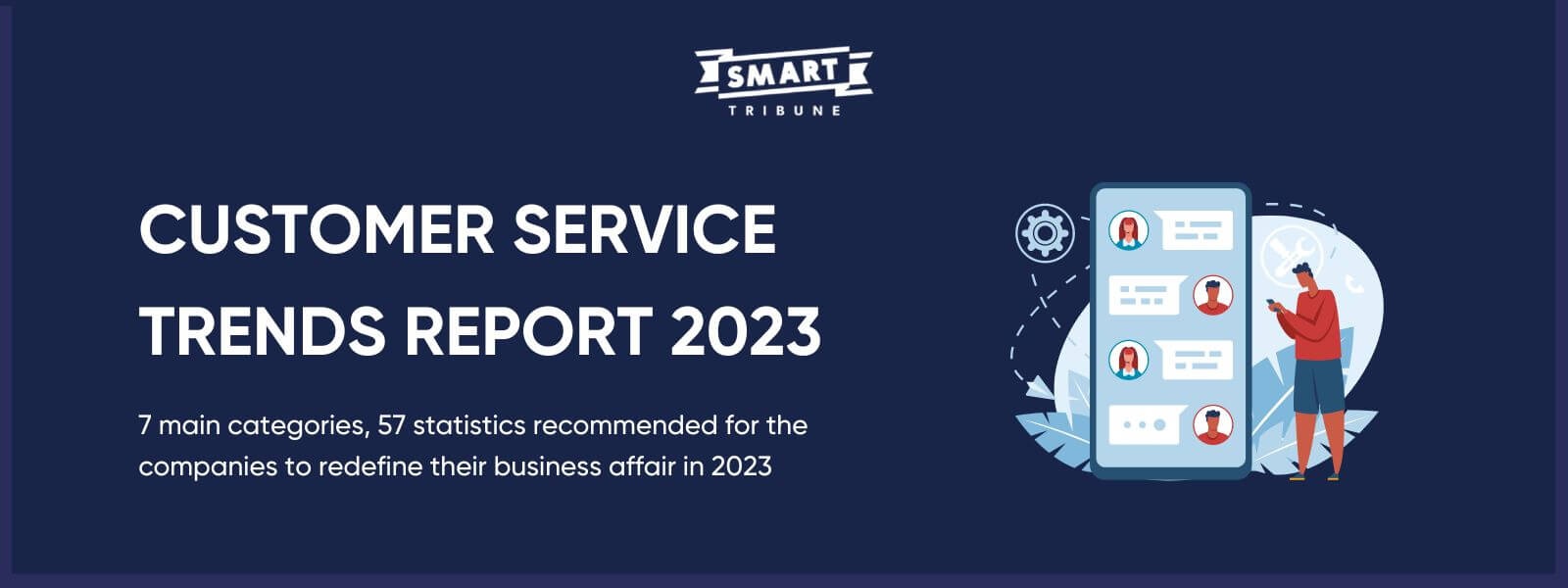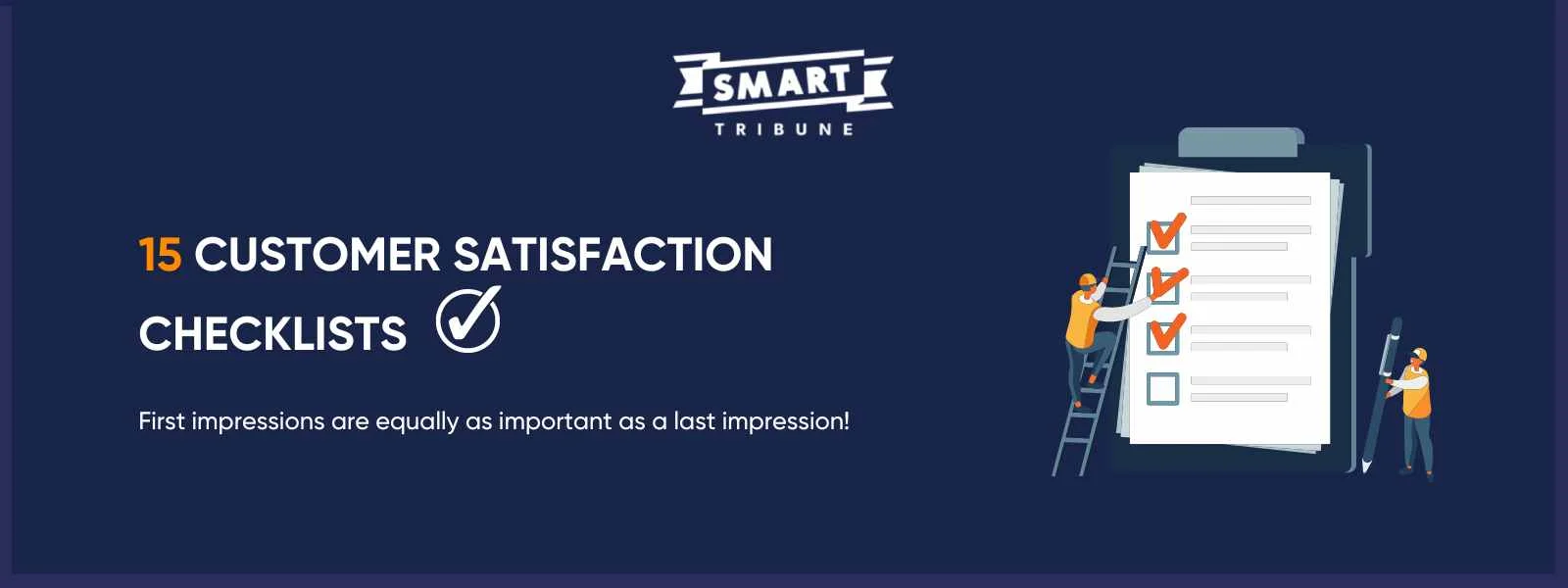
Every business, whether big or small, is made up of tons of moving parts. But the one constant across all businesses is customers. And without customers, businesses don’t exist. That’s why maintaining ongoing customer communications is not only a must-have element of any business but also the foundation of customer experience today. Unfortunately, with so many things going on every single day, it’s all too easy to let your customer communications go off the rails. In this article, we’ll take a closer look at why building an effective communication strategy with your customers is so critical for the success of your business and how to put that customer communications strategy in place. Read on to learn more.
Table of content
- The importance of maintaining strong customer communications
- 5 tips for improved customer communications
- Successful customer communication management strategies
- Automate customer service communications with Smart Tribune

The importance of maintaining strong customer communications
Obviously, communicating with your customers—the people who are ultimately buying your products and services and, therefore, keeping your business growing—is important. After all, communication is the foundational element for all sales and marketing activities. But implementing a strong and ongoing customer communications strategy has a few key perks:
- Speedier customer support: All too often we see customer service overlooked when businesses build their customer communications strategies. But doing so is a missed opportunity to optimise and reinforce one of a brand’s most customer-facing touchpoints. As we all know, when customers reach out for help, they don’t want to wait for days—much less hours—to get a response.
Building customer service communication into your broader strategy is a great way to ensure that your (potentially) highest value and most loyal customers don’t churn because they’ve been left hanging for too long. Improved customer service is a simple way to nurture an existing customer relationship and also build new ones. - Reduced support request volume: The quicker customers get a response when they need help—or are able to find the information they’re looking for on your site, with the help of effective customer self-service solutions—the number of requests into your customer service team will inevitably go down.
In fact, we’ve seen that implementing solutions like smart customer service chatbots can answer up to 70% of simple, FAQ-related questions with ease. This allows customers to be more autonomous throughout their experience with a brand and, as a result, minimises their need to reach out to customer service in their search for information.
In other words, the more information you communicate to customers—whether through your site’s content, via various marketing channels, or with the help of customer self-service solutions—the less they’ll need to ask for your help. This is important because, aside from empowering your customers to be more autonomous on their journey, it also frees up your customer service agents’ time to focus on more complex or sensitive customer service issues that require their undivided attention. - Improved conversion: When customers shop around for new products and services—especially if they are new to your brand—a little compare-and-contrast research is typically in order. So the more you can communicate the features and benefits of whatever you offer, and also make it super easy for customers to find whenever they engage with your brand across all marketing channel, the more confidence you’ll drive in their eventual purchase decision.
This has a direct impact on conversion. After all, when you give customers the essential tools and resources to make informed purchase decisions, they are more likely to complete a transaction (aka, convert) and, if they are satisfied with your products and services, become repeat or recurring customers. This is the dream for any business. - Sustained customer loyalty: Couldn’t have imagined a better segue here. Half of the battle of driving brand loyalty is getting customers to make their first purchase. That’s the ‘hook’ that brings them into the fold. Their satisfaction with your products and services from that point forward simply reinforces confidence in their purchase decision. After that, it’s a matter of constantly reminding them of your brand’s long-term value.
Customer communications, therefore, plays a central role here because it’s a proven way to create effective, ongoing ‘drum beats’ that keep your brand top-of-mind with customers day in and day out. And especially in today’s media-saturated world, where peoples’ attention is being pulled in pretty much every direction at all hours of the day, strong customer communications is the key to staying relevant with customers and ensuring that they remain loyal to your brand over time. - Better customer experience: No surprise here that a solid customer communications strategy will create a better overall customer experience—across all touch points of the customer journey. Content and communication is still very much ‘king’ today. It plays a big part in how customers find your brand, learn more about the products and services you offer, compare your brand to other competitors, and stick with you for the long haul.
By maintaining an ongoing dialogue with your customers, you can effectively build a more personal brand experience that boosts customer retention, increases customer lifetime value (LTV), improves customer satisfaction (and happiness!), and nurtures customer loyalty. This is the core for providing an exceptional customer experience.
“Customer relationships are precious to your company, and customer communication is how you nurture, protect, and grow them."
— Source: A Complete Guide to Customer Communications (FrontPage)
5 tips for improved customer communications
Now that we’ve explained all the good that can come from having a strong customer communications strategy in place, you may be wondering how to actually put it into action. Here are five tried-and-true tips that can transform your customer communications overnight.
1. Build an omnichannel customer communication strategy
It’s no secret that we believe deeply in the value of an omnichannel customer experience. Today’s customers engage with brands every day across multiple channels and platforms. This is why brands must be present wherever their customers are. This could mean doubling down on your website content or expanding into new social media channels. Every brand is a bit different, based on the products and services you offer or the kinds of customers you attract.
The same applies to customer service. When customers have questions or need help, they will first seek out the channels they’re most comfortable using, typically picking up the phone as a last resort. The latter is especially true for younger, more digitally-savvy consumers. Knowing that different customers may have different customer service outreach preferences, it’s important for brands to be available and accessible on the channels that their customers regularly use. This includes phone, email, live chat, messaging, text/SMS, and, of course, customer self-service solutions like dynamic FAQs, chatbots, and in-context help widgets.
While having all of these different customer service communications channels may seem like a lot to manage, it’s been shown that businesses with an omnichannel customer service strategy retain 89% of customers, on average, versus those without (33%). And because customer retention is the key to any successful business, there’s no good reason for ever putting an arbitrary limit on which communications channels your customers can use whenever they need to engage with your brand, whether for getting help, making purchases or otherwise.
2. Prioritise improving the customer service experience
As mentioned above, improved customer communications has a direct link and impact on the customer service experience. This can materialise in a number of ways, including:
- Giving customers quick and easy access to all available customer service channels
- Implementing customer self-service solutions to drive greater customer autonomy
- Using support automation to provide fast, efficient, and effective support
- Personalising the customer service experience throughout the customer journey
Once you start to see customer service as not simply yet another customer communications channel but rather one of your brand’s most direct and influential ways of maintaining a positive dialogue with customers over time, you’ll see that improving customer service communications can go a long way towards transforming the entire customer experience for the better. And when done right, it can serve a greater purpose beyond “traditional customer service” alone, further amplifying other sales and marketing tactics that revolve around increasing conversion, reinforcing customer loyalty, boosting customer satisfaction, and more.
3. Deploy chatbots for automated customer service communications
Oftentimes, when customers come to your site, they are looking for information and, ideally, would prefer to not have to search high and low to find it. And knowing that the vast majority of answers to their questions can be easily automated, chatbots have become a great way of providing customers with instant support wherever they are on your site.
Among the benefits of customer self-service chatbots, here are a few worth calling out:
- Omnipresent support: Unlike your customer service agents who must sleep every now and then, chatbots can work around the clock without tiring. Your customers might live all around the world and not necessarily visit your site during typical customer service business hours. But that doesn’t mean you should immediately invest in an “after hours” customer service team—because that can become costly, too.
Additionally, chatbots are pretty much accessible at any point along your site’s customer journey, which means that, when customers get stuck or need help, they can engage with a chatbot in real-time and get immediate answers. This is important because these critical friction points, if left unattended, could spell the difference between a conversion and a customer bouncing from your site.
And finally, as the cherry on top, research shows that your customers will likely appreciate your investment in chatbots, too. In fact, 68% of consumers have said they like chatbots because they provide quick responses. Therefore, it’s this powerful combination of 24/7 accessibility and cost savings that make implementing customer self-service chatbots are real no-brainer for any brand. - Efficient support communications: While there will always be support requests where living, breathing customer service agents need to intervene, it has been found that customer self-service chatbots can typically handle 68.9% customer chats from start to finish without needing to escalate the request to a customer service agent.
On top of that, from the customer’s perspective, it doesn’t really matter if they’re engaging with a chatbot or a real customer service agent; the only thing that matters to them is resolving whatever issue they have at that moment in time. This is why the average satisfaction rate of chatbot-only chats has hovered as high as nearly 88%.
Not only does this mean customers will get their questions answered or issues resolved more quickly, but it also leads to a decrease in the number of customer service requests that reach the customer service team. It’s a win-win across the board—and a great strategy for optimising your agents’ time.
4. Measure customer experience metrics regularly
Just because we’re talking about “customer communications” doesn’t mean that you shouldn’t be measuring it in some way. After all, adding data-supported rigor to your customer communications strategies is an objective way to identify customer communications gaps, uncover opportunities for improvement, and assess your customer service team’s strengths and weaknesses, including their mastery of critical communication skills.
There are actually a number of metrics you can use to measure the effectiveness of your customer communications strategies. Here are a just a few to consider:
- First Response Time (FRT): Measures how quickly a customer receives a response after a support request has been submitted. Depending on the expectations you’ve set with your customers after they’ve submitted a support request—for example, some brands may say it could take 24 hours to receive a response—your goal is to hit that service level agreement (SLA) or exceed those expectations by responding even faster. This metric can help you understand how well you’re living up to your promises.
- Average Resolution Time (ART): Measures the time it takes to resolve a customer issue in its entirety. Typically, customer service teams want to resolve support issues as quickly as possible because if they drag on for too long, there’s a greater chance it will negatively impact customer satisfaction and potentially tarnish a customer’s perception of your brand. That being said, not all support requests are created equal, meaning that more complex customer service issues will always require more time than responses to FAQ-oriented questions.
- Customer Satisfaction (CSAT): As the name implies, this score is captured after a customer service interaction to gauge whether or not they were pleased with the overall experience as well as the outcome of that interaction. Obviously, brands want their customers to be satisfied at all times, making the CSAT score a great way of identifying what incremental improvements can lead to higher levels of customer satisfaction over time.
5. Collect customer feedback and take action on it
Your customers are your best allies. They know what they like, and they are typically more than happy to share their candid thoughts with you—whether they’ve had a positive or negative customer service experience. So, give them an opportunity to do so. You might just uncover a useful (or overlooked) morsel of insight that can help shape your customer experience for the better and take your customer communications to the next level.
Fortunately, getting customer feedback is fairly easy to do: via social media, in post-call surveys and questionnaires, or even during customer service interactions themselves. But if you decide to collect feedback of any sort, you must embrace it with open arms—listening skills, anyone?—and then actually do something with what your customers have told you. After all, what good does all that feedback serve if it’s just collecting dust somewhere?
“Don’t ask for feedback if you don’t have intention, capacity, and a plan to take action on it....Companies that send surveys but don’t act actually hurt their customer relationships."— Source: A Complete Guide to Customer Communications (FrontPage)
Successful customer communication management strategies
Gartner defines customer communication management as the “strategy to improve the creation, delivery, storage, and retrieval of outbound communications.” While this is completely true, customer communication management takes on a slightly different form in the realm of customer service. That’s because customer interactions are highly interpersonal in nature.
Therefore, it’s less a question about ‘push’ tactics, as insinuated by this definition above, but more so about meeting customers wherever they are in their journey with your brand—and then doing whatever you can to help them get over their obstacles, big or small.
So, keeping this in mind, be sure to prioritise the following more “human” elements into your customer service communication strategy:
- Contact escalation: Obviously, this is part of any customer service experience. However, what’s important here is thinking about how to streamline and simplify the contact escalation process. You don’t want to give your customers the runaround. Even if they’ve begun their customer service journey via customer self-service solutions, if their question or issue is too complicated for an automated solution to resolve, then there’s got to be a quick and easy way to pass the request over to an agent who can help. Remember, your goal should always be to help customers resolve their issues as quickly as possible. The contact escalation process should be designed to do just that.
- Personalisation: Today’s customers like knowing that you genuinely care about them. But they can also tell when they’re being spoken to in a generic way. Be sure to tap into any relevant information they’ve provided within their customer profile—including past purchase details—or even queues based on wherever they are on your website to customise your communications with them. Recognizing them as people (and not just people who purchase your goods) can make a huge difference in their experience.
- Positive attitude: Both your agents and your automated customer self-service solutions need to engage with customers in a friendly, upbeat, “yes, I can solve your issue” way. Even the slightest changes in voice and tone can transform a customer service experience in powerful ways. But this is something that must be practised and trained in an ongoing way in order to avoid getting stuck in a rut. That being said, imagine yourself in your own customers’ shoes: Who would you rather have on the other end of the line, someone who’s eager to help or someone who sounds burdened by your issues? The answer here should be fairly obvious.
- Added empathy: In a similar vein to having a positive attitude, customers today also expect brands—and anyone who acts as a “face” for those brands, including and especially customer service agents—to lead with empathy, build a rapport (even if purely through a digital means), and genuinely show they care. This became even more apparent at the height of the COVID-19 pandemic. As the world was put under immense stress and uncertainty was swirling in the air, people needed a lot more reassurance—and they expected that to be a part of their customer service interactions.
- Jargon-free speak: It’s very easy to read from scripts and regurgitate pre-packaged messaging. While staying on-message is certainly important in any customer communications strategy, failing to speak to your customers as humans—and in their own voice—is a recipe for disaster. When people need help, they don’t want to hear a lot of blah, blah, blah. So, scrap the jargon or other platitudes and keep your communications straightforward and simple. Not only will that help your customers better understand the path towards resolving their issues, but it will also make them feel as though you’ve made an effort to connect with them on a human level.
“When you acknowledge your customers’ concerns and look for solutions to their pain points, you demonstrate that your company is willing and able to show up for them in tangible ways."
— Source: Lead With Empathy To Enhance Customer Experience (Forbes)
Automate customer service communications with Smart Tribune
As you think about your brand’s broader customer communications strategy, it’s important to remember that customer service should ultimately factor into it in some way. This is especially true because customer service, in general, tends to be one of the only direct touch points that many customers will ever have with your brand. So, winning here is absolutely critical for improving customer satisfaction, happiness, retention, loyalty, and beyond.
While there are a number of ways to build effective customer communications into your business’s operations, don’t forget the value that customer self-service solutions can bring to the table. Not only do they empower customers to be more autonomous throughout the customer journey—and, as an added bonus, get instant answers to simple questions—but they are also cost- and resource-effective ways of providing efficient, around-the-clock support.
And when you bring all of these pieces together, you create a better overall customer experience, which should be the ultimate end goal of every brand today.
To learn more about how to turn customer self-service solutions into your go-to online customer service channel, be sure to check out this insightful webinar today.





.png)



